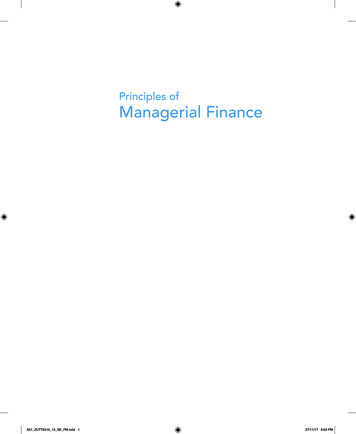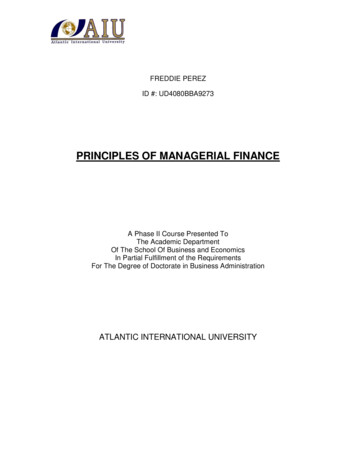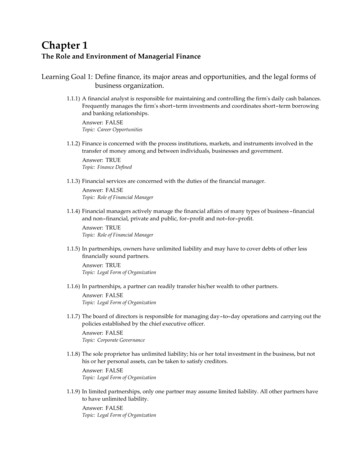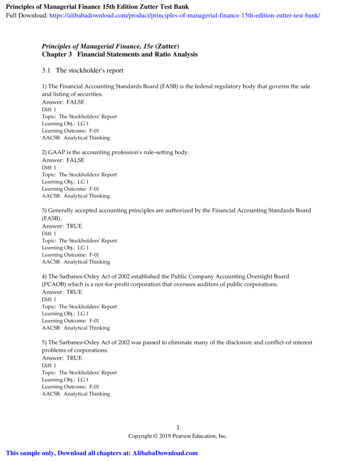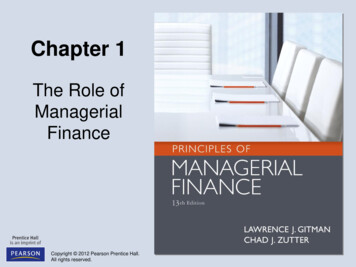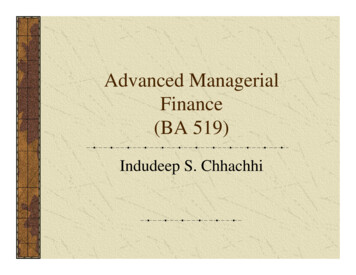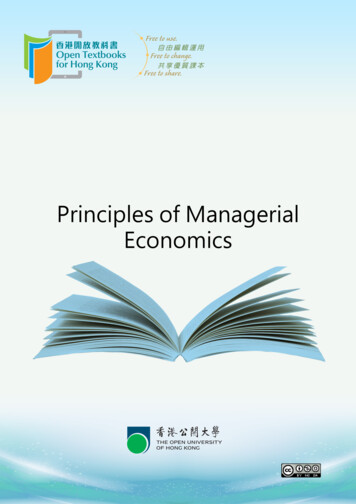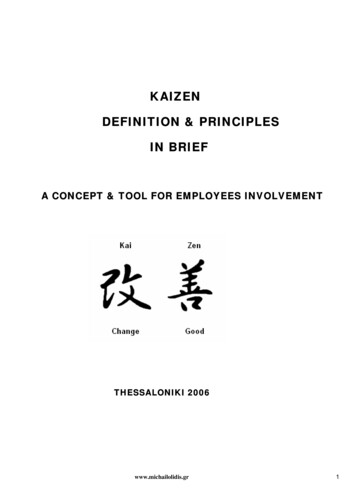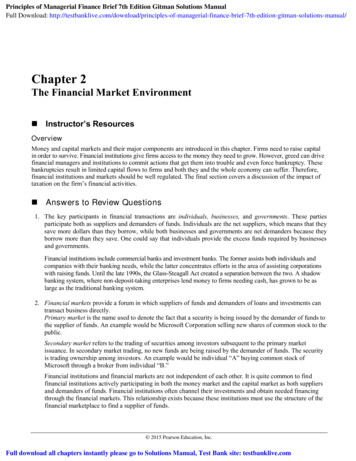
Transcription
Principles of Managerial Finance Brief 7th Edition Gitman Solutions ManualFull Download: -manual/Chapter 2The Financial Market Environment Instructor’s ResourcesOverviewMoney and capital markets and their major components are introduced in this chapter. Firms need to raise capitalin order to survive. Financial institutions give firms access to the money they need to grow. However, greed can drivefinancial managers and institutions to commit actions that get them into trouble and even force bankruptcy. Thesebankruptcies result in limited capital flows to firms and both they and the whole economy can suffer. Therefore,financial institutions and markets should be well regulated. The final section covers a discussion of the impact oftaxation on the firm’s financial activities. Answers to Review Questions1. The key participants in financial transactions are individuals, businesses, and governments. These partiesparticipate both as suppliers and demanders of funds. Individuals are the net suppliers, which means that theysave more dollars than they borrow, while both businesses and governments are net demanders because theyborrow more than they save. One could say that individuals provide the excess funds required by businessesand governments.Financial institutions include commercial banks and investment banks. The former assists both individuals andcompanies with their banking needs, while the latter concentrates efforts in the area of assisting corporationswith raising funds. Until the late 1990s, the Glass-Steagall Act created a separation between the two. A shadowbanking system, where non-deposit-taking enterprises lend money to firms needing cash, has grown to be aslarge as the traditional banking system.2. Financial markets provide a forum in which suppliers of funds and demanders of loans and investments cantransact business directly.Primary market is the name used to denote the fact that a security is being issued by the demander of funds tothe supplier of funds. An example would be Microsoft Corporation selling new shares of common stock to thepublic.Secondary market refers to the trading of securities among investors subsequent to the primary marketissuance. In secondary market trading, no new funds are being raised by the demander of funds. The securityis trading ownership among investors. An example would be individual “A” buying common stock ofMicrosoft through a broker from individual “B.”Financial institutions and financial markets are not independent of each other. It is quite common to findfinancial institutions actively participating in both the money market and the capital market as both suppliersand demanders of funds. Financial institutions often channel their investments and obtain needed financingthrough the financial markets. This relationship exists because these institutions must use the structure of thefinancial marketplace to find a supplier of funds. 2015 Pearson Education, Inc.Full download all chapters instantly please go to Solutions Manual, Test Bank site: testbanklive.com
14Gitman/Zutter Principles of Managerial Finance, Brief, Seventh Edition3. The money market is created by a financial relationship between the suppliers and demanders of short-termdebt securities maturing in one year or less, such as U.S. Treasury bills, commercial paper, and negotiablecertificates of deposit. The Eurocurrency market is the international equivalent of the U.S. money market andis used for short-term bank time deposits denominated in dollars or other major currencies.4. The capital market is a financial relationship created by a number of institutions and arrangements that allowsthe suppliers and demanders of long-term funds (with maturities greater than one year) to make transactions.The key securities traded in the capital markets are bonds plus common and preferred stock.5. The broker market consists of national and regional securities exchanges. These organizations provide alocation, such as the New York Stock Exchange, to bring together the buyers and sellers of debt and equity.They create a continuous market for securities, allocate scarce capital, determine and publicize security prices,and aid in new financing.In contrast, dealer markets are electronic markets for the buyers and sellers of securities not listed on themajor exchanges. In a dealer market, physical trading locations are replaced by security dealers who offer tobuy or sell securities at stated bid/ask prices. Dealers buy securities from clients and sell them to otherdealers, who in turn sell them to their clients. A majority of shares traded in the dealer market are listed onNasdaq, the National Association of Securities Dealers Automated Quotation System.6. In addition to the U.S. capital markets, corporations can raise debt and equity funds in capital markets locatedin other countries. The Eurobond market is the oldest and largest international debt market. Corporate andgovernment bonds issued in this market are denominated in dollars or other major currencies and sold toinvestors outside the country in whose currency the bonds are denominated. Foreign bond markets alsoprovide corporations with the opportunity to tap other capital sources. Corporations or governments issuebonds denominated in the local currency and sold only in that home market. The international equity marketallows corporations to sell blocks of stock to investors in several countries, providing a diversified investorbase and additional opportunities to raise larger amounts of capital.7. An efficient market will allocate funds to their most productive uses due to competition among wealthmaximizing investors. Prices are assumed to be a function of information about the firm and economy. Onlynew, unexpected information will cause investors to buy or sell securities. Investors determine the price ofassets through their participation in the financial markets. Changes in supply and demand continually impactprices in an efficient market.An alternate view of market pricing is put forth by advocates of behavioral finance. This explanation of marketprices combines finance and psychology. Though prices may deviate from true value for psychological andother reasons, few investors have been able to earn a risk-adjusted, positive rate of return.8. Securitization is the process of pooling mortgages and then selling claims against that pool in the secondarymarket. Investors buying these securities extend a loan to the homeowner.9. Mortgage-backed securities represent claims on the cash flows generated by a pool of mortgages. As thehomeowners pay off their mortgages, the money serves as income to the investors. The primary riskassociated with mortgage-backed securities is that homeowners may not repay their loans.10. When a homeowner borrows money to buy a home, he borrows a fixed amount of money. As housing pricesrise, the gap between what he owes and what the house is worth widens. Lenders will allow borrowers whohave difficulty making mortgage payments tap this built-up equity. Therefore, mortgage default rates arerelatively low. 2015 Pearson Education, Inc.
Chapter 2: The Financial Market Environment1511. As home prices decline, the value of homes may be less than the amount owed to the bank. Hence manyborrowers will simply walk away from their homes and let lenders repossess them. There will be an addedsupply of housing. If multiple homes in the area are facing foreclosure, the value of remaining homes willdrop. At the same time, borrowers having trouble making mortgage payments will not be able to tap into anybuilt-up equity. These homes will also be repossessed, and the number of homes for sale in an area will rise.Excess home availability will make the remaining homes less valuable, increasing the number of homeownerswith houses worth less than the amount owed to the bank.12. A crisis in the financial sector generally has a spillover effect on the other sectors of the economy. This canbe better understood by understanding the 2008 financial crisis. As mortgage-backed security delinquencyrates rose, the value of still solvent mortgage-backed securities fell. This fall led to the questions about thesolvency of investors, including financial institutions. Financial institutions cut back on the amount oflending, requiring higher standards for those borrowing money. Unable to obtain money easily in the moneymarket, firms began to hoard cash and cut back expenditures. This decline hurt suppliers and curtailedemployment at companies. Throughout the economy, revenues fell as financial institutions cut back onlending.13. Due to their enormous impact, governments typically regulate financial institutions more than most economicsectors. Banking sector troubles and other factors contributed to the worst economic contraction in U.S.history during the Great Depression. Consequently, it is not surprising that an above-average amount oflegislation was enacted in the 1930s.14. The Securities Act of 1933 was designed to regulate activity in the primary market, ensuring that sellers ofnew securities provided extensive disclosure. The Securities Exchange Act of 1934 regulates the trading ofsecurities in secondary markets. The latter legislation also created the Securities Exchange Commission toenforce federal securities laws.15. The ordinary income of a corporation is income earned through the sale of a firm’s goods or services. Taxeson corporate ordinary income have two components: a fixed amount on the base figure for its income bracketlevel, plus a progressive percentage, ranging from 15% to 39%, applied to the excess over the base bracketfigure. A capital gain occurs when a capital asset is sold for more than its initial purchase price. Capital gainsare added to ordinary income and taxed at the regular corporate rates. The average tax rate is calculated bydividing taxes paid by taxable income. For firms with taxable income of 10 million or less, it ranges from15% to 34%. For firms with taxable income in excess of 10 million, it ranges between 34% and 35%. Themarginal tax rate is the rate at which additional income is taxed.16. Dividends received from another corporation, in which the shareholding firm’s position is less than one-fifthof outstanding shares, is subject to a 70% exclusion for tax purposes. The tax rate is only 30% of what itwould be on fully taxable income.17. The tax deductibility of corporate expenses reduces their actual after-tax cost. Corporate interest is a taxdeductible expense, while dividends are not. Suggested Answer to Focus on Practice Box: Berkshire Hathaway: CanBuffet Be Replaced?The share price of BRKA has never been split. Why might the company refuse to split its shares to makethem more affordable to average investors?The primary reason that Berkshire Hathaway does not split the price of its common stock is because WarrenBuffett’s philosophy is that a stock split is financially meaningless and only serves as a way to lower the stockprice so that more investors are able to purchase the stock. Mr. Buffett has stated his belief that true investors are 2015 Pearson Education, Inc.
16Gitman/Zutter Principles of Managerial Finance, Brief, Seventh Editionlong-term investors who hold a stock through thick and thin. With fewer shareholders, there are fewer people thatthe company management must answer to, and investors who can afford the steep price of the Berkshire Hathawaystock are likely to be serious individual investors or institutional investors such as mutual funds. Answers to Warm-Up ExercisesE2-1.Suppliers and demanders of fundsAnswer: Individuals as a whole spend less than they earn. The excess is invested, making it available forbusinesses. If individuals consume more, fewer dollars will be available for investment. This wouldreduce the amount of money available for new projects and drive up the required return (i.e., requiredreturn of investors buy bonds). Over time, employment, salaries, and gross domestic product woulddecline.E2-2Raising fundsAnswer: Financial institutions, such as investment banks, provide expertise in the acquisition of funds.Investment banking institutions are able to use the expertise developed through the acquisition of fundsfor many firms to reduce the effort and cost of acquiring funds for any single business. The investmentbanking institution will allow the Gaga Enterprises’ CFO to raise more money at a lower cost per dollarraised.E2-3Money market vs. capital marketAnswer: Money markets are short-term markets, so firms using these would be in need of funds for less than ayear. Perhaps the business needs to increase inventory for a season, such as RV dealerships buildinginventory prior to the spring/summer sales period. Immediately after a large sale, a business may needto finance the presence of accounts receivable on their balance sheet. Capital markets, by contrast,typically are used for fixed assets, which a company will use over several years.E2-4Mortgage-backed securitiesAnswer: Questions you would ask includea. Real estate location (after all, the three most important determinants of real estate price are“location, location, location”)b. Percentage of properties in the region that are “under water” (homeowners owe more than theyborrowed) or in foreclosurec. Type of real estate (commercial properties offer less liquidity if the market turns sour becauseempty homes can be rented for revenue)d. Precedence in bankruptcy (would other lenders have a senior claim to properties in bankruptcy?)e. Quality of real estate (is it in good condition, or would there need to be repairs prior to sale?)f. Creditworthiness of borrowers (how likely is it that borrowers will lose their job and be unable tomake payments on a timely basis?)g. What percentage of borrowers are behind on their mortgage payments?h. Will borrowers soon be experienci
Principles of Managerial Finance, Brief,

